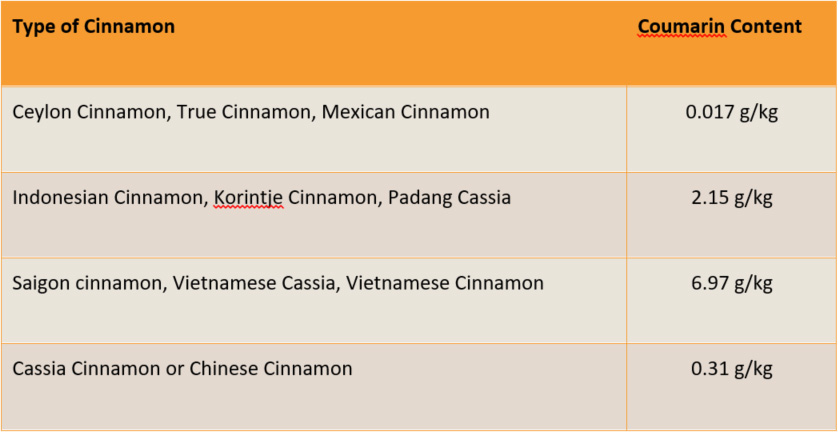Ceylon True Cinnamon
True Cinnamon is originally native to the Island of Sri Lanka, 90% of the World’s Ceylon Cinnamon still comes from there. Even in Sri Lanka, high quality Ceylon Cinnamon only grows in the South West corner of the Island due to some very unique soil and weather conditions. It is for this reason, as well as its unique properties that Ceylon Cinnamon is often called “True Cinnamon ” or real Cinnamon.
If you are taking Ceylon Cinnamon for health benefits, then stick to good quality natural Ceylon Cinnamon Sticks.
Ceylon Cinnamon powder or Ceylon Cinnamon Black Tea infused with Ceylon Cinnamon Bark Oil.
Ceylon cinnamon has a mild yet slightly sweeter taste. Ceylon Cinnamon is not overtly spicy and harsh like Cassia Cinnamon, but creates a more sophisticated flavor profile in fine desserts recipes and Asian curries.
Boiled Ceylon Cinnamon sticks made into a deep reddish tea is a fabulous taste treat with many health benefits without the downside of Cassia Cinnamon.
How is Ceylon Cinnamon Made
Ceylon Cinnamon is made first by cutting a branch of the Cinnamon tree called Cinnamomum Zeylanicum Blume.
At harvest workers break down the branches early in the morning when the bark is still moist, branches will not get dry if it is cut in the morning.
If it is done at noon branches will dry out and it is difficult to work with those branches.
If the tender branches are hard and twisted, those branches should be cut down. The branches that are straight and steady should be kept.
Wash the cut branches to remove soil.
Peelers have to do the delicate and essential work of stripping. It has to remove knots of the cinnamon sticks, after removing knots the outer bark is scraped very carefully with a special knife
Once this is done the Cinnamon peeler will rub a special stick against the bark the cinnamon bark loosens.
This is when the soft inner bark is ready to be gently peeled. The idea is to peel one single long piece of bark. This is only possible if you get a straight branch with little or no knots.
Once it is peeled, smaller slivers of Cinnamon Bark are then packed into one long unbroken piece of Cinnamon Bark and left to dry naturally overnight.
This is the most labor-intensive part of the process and it is not easy.
Once it is peeled, smaller slivers of Cinnamon Bark are then packed into one long unbroken piece of Cinnamon Bark and left to dry naturally overnight.
Once dried the Cinnamon becomes a light brown color. It is then cut to smaller lengths according to need.
If there are too many smaller pieces, these are dried on their own without being rolled and then made into powder or used for steam distilling into Ceylon Cinnamon Bark Oil.
Quality Parameters of Ceylon Cinnamon
Quality Parameters of Cinnamon
Colour
Yellowish Brown to slightly reddish colour
Ground cinnamon – yellowish brown
Odure
Ceylon cinnamon’s flavor and aroma are extremely mild and delicate.
Characteristic fresh aroma
Flavour
Ceylon cinnamon is delicate and sweet flavour characteristic.
Forms of Cinnamon
Cinnamon is a tropical evergreen tree whose parts, either the bark or the leaf are used for a variety of purposes. The parts of the tree is broken down into many parts as follows.
• Cinnamon chips (like wood chips) made from the bark of the tree.
• Bark from the tree trunk rolled into sticks that are 42 inches or 21 inches long.
• The Cinnamon bark from the tree trunk ground into Cinnamon powder.
• The Cinnamon leaves from the tree steam distilled into an oil.
• The Cinnamon bark steam from the tree trunk distilled into an oil.
How is Cinnamon Used
Sticks – However because Cinnamon powder goes stale quickly many people buy the cinnamon stick and use it whole in cooking, especially Asian curries. Many fine chefs will grind it into a powder for making fine desserts. However if you buy cinnamon powder that is packed in a sunlight and moisture proof package it will be much fresher than the powder sold in those glass containers found on supermarket shelves.
Powder – The most common way cinnamon is used as Cinnamon powder for baking pastries, sprinkled on coffee or tea and just mixed with honey and eaten direct.
Oil – The Cinnamon oil which is made by steam distilling the leaves of the Cinnamon Tree or Cinnamon Bark is heavily used in food processing, fine perfumes, aroma therapy, medication (especially Asian medication), and disinfectants.
World’s best Cinnamon Powder
World’s best Cinnamon Oil
Ceylon cinnamon oil is more expensive compared to cassia cinnamon. This is because Ceylon Cinnamon Oil is much harder to extract. The Ceylon Cinnamon Bark Oil resides in the inner bark of the Ceylon Cinnamon tree.
It has to be peeled very carefully and then steam distilled. There is only about 1% oil in this thin sliver of bark. But once you extract it you have one of the most exotic essential oils. All you need is 1-3 drops either for aroma or to add to a drink.
Cinnamon oil is a widely used ingredient in the food and beverages industry. It is one of the main ingredients in many products including sugar-free gum and hard candy. It is also used in the preparation of commercial baked goods as a natural food preservative. Cinnamon oil is also used as flavouring in tea and wine.
Cinnamon Bark Oil is often mixed in Tea, coffee, milk, health drinks like bulletproof coffee or fruit smoothies for energy. It adds flavor and other benefits. Usually 1 drop and certainly no more than 3 drops because this essential oil is spicy, hot and sweet.
Cinnamon is an antioxidant, antimicrobial and anti-inflammatory, but it can also add a warm and spicy layer to your favorite meal, coffee or hot chocolate. Perfect for savory dishes like bone broth, soups or stews, this essential oil.
It is that powerful. Significantly free of contaminants, especially Coumarin, it has some very powerful health benefits.
No wonder it is the first and only choice for the World’s best food manufactures like Coca Cola to the French perfume industry.
What Makes Ceylon Cinnamon So Special
01. Ultra low Coumarin content
Ceylon Cinnamon has low Coumarin levels of 0.02% compared to 0.4 – 0.8% for Cassia type Cinnamon. Even at levels of 0.4 – 0.8% Coumarin is considered dangerous to your liver.
Ceylon Cinnamon however can be consumed on a daily basis without undue concerns. Having said that, you should only consume moderate levels of even Ceylon Cinnamon. Too much of anything can cause toxicity in our body.

02. Flavor
Ceylon cinnamon’s flavor and aroma are extremely mild and delicate—it definitely reads as “cinnamon,” but with subtle, almost floral notes in there.
A strong Cinnamon taste might work for a few overtly Cinnamon tasting recipes, but the vast majority of recipes would be better off with Ceylon Cinnamon.
In Sri Lanka, the home of Ceylon Cinnamon, it is added to many curries to create a savory taste. Mexican recipes which make extensive use of Ceylon Cinnamon came from Spain which in turn discovered Ceylon Cinnamon nearly 400 years ago. That means many of these European Cinnamon recipes have had centuries to create multi layered flavors with subtle combinations of Cinnamon and other spices.
03. Sweetness
Ceylon Cinnamon tends to be slightly sweeter with notes of citrus and clove. It has no sugar however. The slight sweet taste of Ceylon Cinnamon is an advantage if you, like many diabetics, drink or eat cinnamon on a daily basis.
For example when you make some authentic Mexican Te de Canela with Ceylon Cinnamon you will find that it is surprisingly sweet without sugar.
But the sweet taste has another advantage. It works very well with fine desserts. The blend of Ceylon Cinnamon creates a very sophisticated taste profile without the need for so much sugar.
04. Fragrance & Aroma
Ceylon Cinnamon has an amazing aroma. Try some Ceylon Cinnamon French Toast or Cinnamon roll made with the Ceylon Cinnamon powder.
You will suddenly realize how much better it is. The whole house will waft in a truly intoxicating scent.
Boil a Ceylon Cinnamon stick into tea. The aroma is particularly good in the Ceylon Cinnamon Bark Oil because it has the highest levels of Cinnamaldehyde, the compound that makes that characteristic Cinnamon smell.


